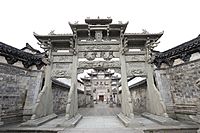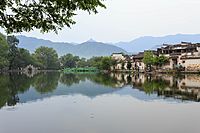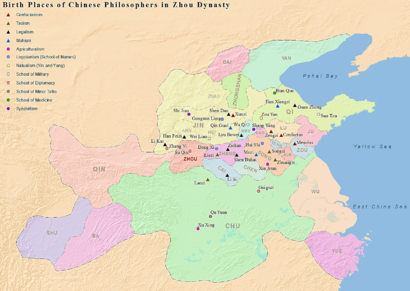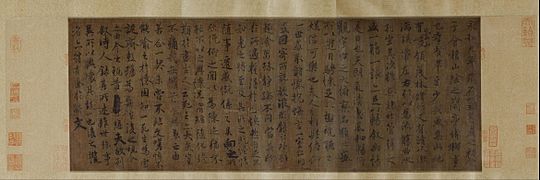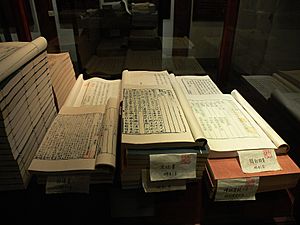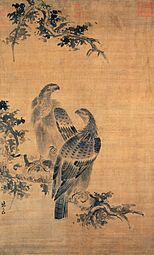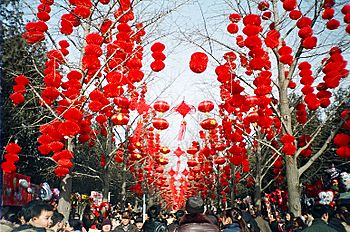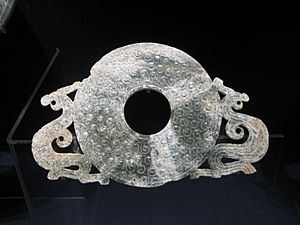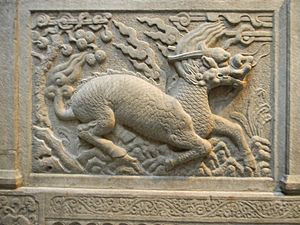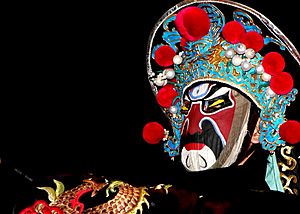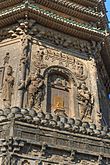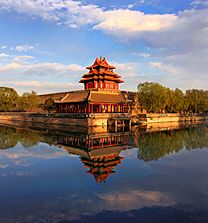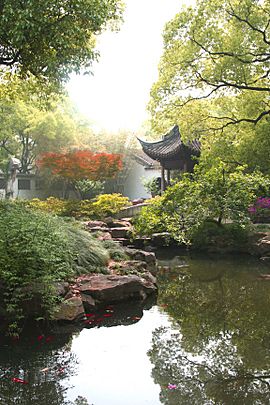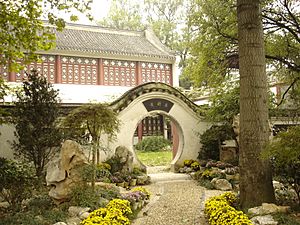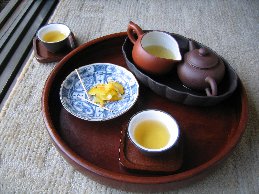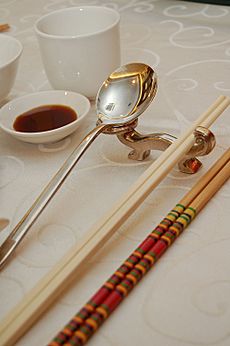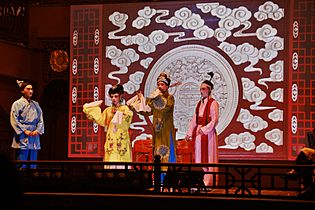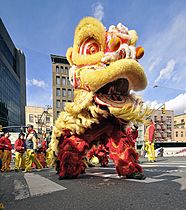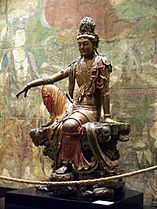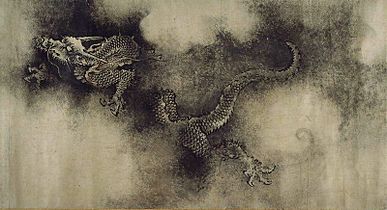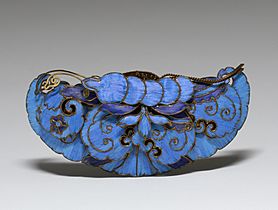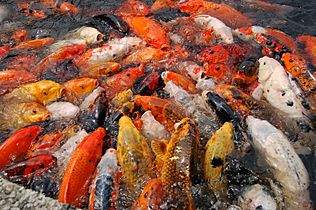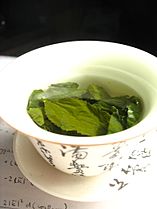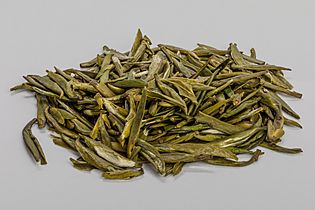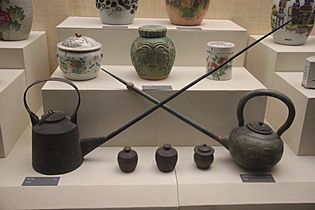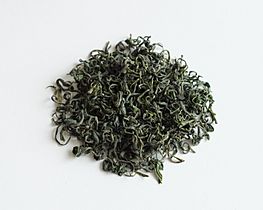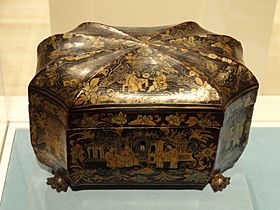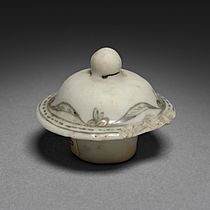Chinese culture facts for kids
Chinese culture (simplified Chinese: 中华文化; traditional Chinese: 中華文化; pinyin: Zhōnghuá wénhuà) is one of the oldest cultures in the world. It started thousands of years ago. This culture is found across a huge area in East Asia. It is very diverse, with different customs and traditions in different provinces, cities, and even towns. The name 'China' and its land have changed over many centuries. The last big empire was the Great Qing, before 'China' became the common name we use today.
Chinese civilization has always been a very important culture in East Asia. China is one of the earliest ancient civilizations. Its culture has greatly influenced the ideas, manners, and traditions of all Asia. Things like Chinese characters, pottery, buildings, music, dance, books, martial arts, food, art, ways of thinking, and festivals have spread around the world. People everywhere celebrate and practice them.
Contents
- Who are the Chinese people?
- Different Regions, Different Customs
- How Society Was Organized
- Spiritual Beliefs and Ideas
- Language and Writing
- Calligraphy: Art of Writing
- Chinese Literature
- Fashion and Clothing
- Chinese Arts
- Mythological Creatures in Chinese Culture
- Music, Instruments, and Dance
- Chinese Architecture
- Martial Arts
- Leisure Activities
- Chinese Cuisine (Food Culture)
- Major Subcultures
- Images for kids
- See also
Who are the Chinese people?
From the Qin dynasty to the late Qing dynasty (221 BC – AD 1840), the Chinese government divided people into four main groups. These were landlords, peasants, craftsmen, and merchants. Landlords and peasants were the two biggest groups. Craftsmen and merchants were smaller groups. In theory, no job was passed down from parents to children, except for the Emperor's position.
The largest ethnic group in China is the Han Chinese. They are an East Asian group. They make up about 92% of China's population. They are also 95% of Taiwan's population and 76% of Singapore's. They are the world's largest ethnic group, with over 1.3 billion people.
Modern China has 56 officially recognized ethnic groups. Throughout history, many non-Chinese groups have joined with the Han Chinese. Some kept their own identities, while others disappeared. The Han Chinese have kept their different languages and local traditions for a very long time. The term Zhonghua Minzu (simplified Chinese: 中华民族; traditional Chinese: 中華民族) describes the idea of Chinese nationalism. A big part of traditional identity is linked to the family name.
Different Regions, Different Customs
After the Han dynasty (202 BC – 220 AD), China had 361 years of civil war. During this time, rich and powerful families gained a lot of land and many workers. They controlled important government and military jobs, keeping them for their own families. The Tang Dynasty later used the imperial examination system to try and stop this.
Traditional Chinese culture covers huge areas. Each region often has its own distinct sub-cultures. For example, Guangdong is known for chenpi (dried orange peel), aged ginger, and hay. The ancient city of Lin'an (Hangzhou) is known for tea leafs, bamboo shoots, and hickory nuts. This led to an old Chinese saying: "Customs change every ten li (about 5 km)." The 31 provincial-level divisions of China are grouped by older administrative areas.
How Society Was Organized
Since the time of the Three Sovereigns and Five Emperors, a Chinese monarch has been the main ruler. Different times in history had different names for jobs in society. But generally, government and military officials were high up. Everyone else was under regular Chinese law. From the late Zhou dynasty (1046–256 BCE) onwards, Chinese society was organized into classes called the four occupations.
However, this system did not include all groups. The differences between groups became less clear after Chinese culture became more focused on business during the Song dynasty (960–1279 CE). Ancient Chinese education has a long history. Since the Sui dynasty (581–618 CE), educated people prepared for special imperial exams. Those who passed became government officials called scholar-bureaucrats. This created a system where people could get jobs based on their skills, not just their family. But only males who could afford to study for the exams could take them.
To pass the exams, applicants had to write essays and show they knew the Confucian classics very well. Those who passed the highest level became elite scholar-officials called jinshi. This was a very respected position. Trades and crafts were usually taught by a shifu (master). The female historian Ban Zhao wrote Lessons for Women in the Han dynasty. It described four virtues women should follow.
In the mid-19th century, European countries became very powerful. Some Chinese thinkers wanted to combine Chinese and European ideas. The history of 20th-century China was about trying new ways to organize society, politics, and the economy. This was to help the nation recover after the old ruling system ended.
Spiritual Beliefs and Ideas
Most spiritual practices in China come from Chinese Buddhism, Taoism, and Confucianism. The influence of each is debated. Other practices like Neo-Confucianism have also been important. Ideas like Reincarnation remind people of the connection between life and the afterlife. In Chinese business, guanxi means that relationships are often more important than strict rules. Many deities are part of tradition. Some well-known holy figures include Guan Yin, the Jade Emperor, and Buddha.
Chinese Buddhism has shaped Chinese culture in many ways. This includes art, politics, literature, philosophy, medicine, and daily life. Many Indian Buddhist writings were translated into Chinese. These translations, along with Chinese works, were put into a printed collection. This helped spread Buddhism throughout China. Chinese Buddhism also shows how Indian religions, Chinese folk religion, and Taoism mixed together.
Religions in China
During the Xia and Shang dynasties, Chinese religion focused on worshipping the supreme god Shang Di. The king and fortune-tellers acted as priests. They used oracle bones to communicate. The Zhou dynasty later focused on worshipping the broader concept of heaven. A big part of Chinese culture is based on believing in a spiritual world. Many methods of divination (ways to predict the future) have been used. They even served as an alternative to medicine. Folk stories helped explain things that couldn't be understood. The line between myth, religion, and unexplained events is often blurry. Many of these stories have become traditional Chinese holidays.
Other ideas have become spiritual symbols, like Door gods and Imperial guardian lions. Along with good spirits, there is also a belief in evil beings. Practices like Taoist exorcism fight against mogwai (demons) and jiangshi (hopping vampires) using peachwood swords. These are just some of the ideas passed down through generations. Some Chinese fortune telling rituals are still used today.
Taoism is a religious or philosophical tradition from China. It teaches living in harmony with the Tao (道, meaning "Way"). The Tao is a basic idea in most Chinese philosophical schools. In Taoism, it means the source and pattern of everything that exists. Taoism is different from Confucianism because it doesn't focus on strict rules and social order. Taoist ethics often emphasize wu wei (effortless action), "naturalness," simplicity, and humility. The roots of Taoism go back to at least the 4th century BCE. Early Taoism got its ideas about the universe from the School of Yinyang. It was also influenced by one of China's oldest texts, the Yijing. This book explains how human behavior should follow nature's cycles. The Tao Te Ching, a book of teachings by Laozi (Chinese: 老子; pinyin: Lǎozǐ; Wade–Giles: Lao Tzu), is a key work of Taoism.
Chinese Philosophy and Law
Confucianism, also called Ruism, was the official philosophy for most of Imperial China. Knowing Confucian texts was the main way to get into government jobs. Other ideas, like Legalism, which focused on strict laws, were also important. There were often disagreements between these philosophies. For example, Song dynasty Neo-Confucians thought Legalism moved away from the true spirit of Confucianism. Exams and a system based on skill are still highly valued in China today. Some modern Confucians believe that democratic ideas and human rights fit well with traditional Confucian "Asian values."
Confucianism is seen as a tradition, a philosophy, a religion, or simply a way of life. It grew from the teachings of the Chinese philosopher Confucius (551–479 BCE). He saw himself as passing on the values of the Zhou dynasty's golden age. In the Han dynasty (206 BCE – 220 CE), Confucian ideas became the official way of thinking. Emperors often mixed Confucianism with the practical methods of Legalism.
The Hundred Schools of Thought
The Hundred Schools of Thought were different philosophies and schools of thought. They thrived from the 6th century to 221 BC. This was during the Spring and Autumn period and the Warring States period of ancient China. Even though this time was full of chaos and battles, it was also a period of great cultural and intellectual growth in China. It became known as the Golden Age of Chinese philosophy. Many different thoughts and ideas were developed and discussed freely. This time is called the Contention of a Hundred Schools of Thought. The ideas from this period have greatly influenced lifestyles and social consciousness in China and East Asia even today. Scholars during this time traveled around. They were often hired by different rulers as advisors on government, war, and diplomacy. This period ended when the imperial Qin Dynasty rose to power. They later suppressed opposing ideas.
Mohism was an ancient Chinese philosophy that focused on logic, rational thought, and science. It was developed by scholars who followed the philosopher Mozi (around 470 BC–391 BC). The philosophy is found in the book Mozi. Another group was the School of the Military. They studied warfare and strategy. Sunzi (author of The Art of War) and Sun Bin were important leaders. The School of Naturalists combined the ideas of yin-yang and the Five Elements. Zou Yan is seen as the founder of this school. His theory tried to explain the universe using basic forces in nature. These were yin (dark, cold, female, negative) and yang (light, hot, male, positive), and the Five Elements (water, fire, wood, metal, and earth).
Language and Writing
The old written language was Classical Chinese. It was used for thousands of years, mostly by scholars and educated people called "shi da fu." It was hard, but possible, for ordinary people to join this group by passing written exams. Calligraphy later became a business. Works by famous artists were highly valued.
Chinese literature has a long history. The earliest classic work, the I Ching or "Book of Changes," is from around 1000 BC. A time of great philosophy during the Warring States period produced famous works. These include Confucius's Analects and Laozi's Tao Te Ching. Dynastic histories were often written. Sima Qian's Records of the Grand Historian (109 BC to 91 BC) was a very important early work. The Tang dynasty saw a boom in poetry. The Four Great Classical Novels were written during the Ming and Qing dynasties. Printmaking with movable type was developed during the Song dynasty.
Chinese philosophers, writers, and poets were highly respected. They played key roles in keeping and spreading the empire's culture. Some classical scholars were known for showing the lives of common people, which sometimes upset the authorities.
Different Chinese Languages and Writing
At the start of the 20th century, most people could not read or write. The many languages spoken (like Mandarin, Wu, Yue (Cantonese), Min Nan, Hakka, etc.) made it hard for people from different areas to talk to each other. However, the written language allowed communication. Official orders and documents could be sent across all of China. Reformers decided to create a national language. They chose Mandarin, based on the Beijing dialect, as the spoken form. After the May 4th Movement, Classical Chinese was quickly replaced by written vernacular Chinese. This new written style was based on the vocabulary and grammar of the standard spoken language.
Calligraphy: Art of Writing
Chinese calligraphy is an art form of writing. It is the artistic expression of human language in a visible way. There are standard styles of calligraphy in this tradition. Chinese calligraphy and ink and wash painting are closely related. They use similar tools and techniques. They also share a long history of art. Chinese painting and calligraphy focus on movement filled with energy. Calligraphy has also led to other art forms in China. These include seal carving, fancy paperweights, and inkstones.
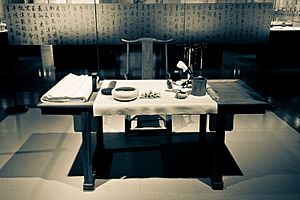
In China, calligraphy is called Shūfǎ (書法/书法). This means "the way of writing." In Japan, it is Shodō (書道/书道), meaning "the way of writing." In Korea, it is Seoye (서예; 書藝), meaning "the skill of writing." Chinese calligraphy is seen as one of the "arts" in countries where it is practiced. It focuses not only on how to write but also on developing one's character. It is taught as a discipline.
Chinese Literature
The Zhou dynasty is often seen as a key time for Chinese culture. Concepts in Chinese classic texts include poetry, astrology, astronomy, the calendar, and constellations. Some of the most important early texts are the I Ching and the Shujing. Many Chinese ideas like Yin and Yang, Qi, and Four Pillars of Destiny were thought about before the imperial periods. By the end of the Qing dynasty, Chinese culture entered a new era with written vernacular Chinese for common people. Hu Shih and Lu Xun were important writers in modern literature. After the People's Republic of China was founded, the study of modern Chinese literature grew. Modern literature has shaped how people think about nationhood and national spirit.
Poetry in the Tang Dynasty
Tang poetry refers to poetry written during China's Tang dynasty (618–907 AD). This time is often called the Golden Age of Chinese poetry. During the Tang dynasty, poetry was an important part of social life. Scholars had to master poetry for government exams. But anyone could try to write it. This led to many poems and poets. Two of the most famous poets were Li Bai and Du Fu. Tang poetry has influenced literature around the world. The Quantangshi ("Complete Tang Poems") has over 48,900 poems by more than 2,200 authors.
Ci Poems in the Song Dynasty
Ci (辭/辞) are a type of lyric poetry in Classical Chinese poetry. Ci poems use specific poetic meters. They have fixed rhythms and tones, but lines can be different lengths. The rhythm and tone of a ci are based on certain musical tunes. They are also called Changduanju ("lines of irregular lengths"). The number of characters in each line and the arrangement of tones were set by about 800 patterns. Each pattern had a special title. Originally, they were meant to be sung to a tune with that title. The Song dynasty was also a time of great scientific writing. Works like Su Song's Xin Yixiang Fayao and Shen Kuo's Dream Pool Essays were created. There were also huge history books and encyclopedias. Examples include Sima Guang's Zizhi Tongjian (1084) and the Four Great Books of Song.
The oldest ci poems found are from the 8th century CE. They were found in Dunhuang manuscripts. The ci form developed from popular songs into a complex literary style. Some of its fixed-rhythm patterns came from Central Asia. The form grew further in the Tang dynasty. The Tang poet Wen Tingyun (812–870) was a great master of the ci. He wrote it in its clear and mature form. Li Yu of the Southern Tang Dynasty was another important writer of this form. However, the ci form is most linked with the poetry of the Song Dynasty. It was a very popular poetic form then. The ci poetry form became popular again at the end of the Ming dynasty and the start of the Qing dynasty. During this time, poets explored emotions about romantic love.
Qu Poems in the Yuan Dynasty
The Qu form of poetry is another type of Classical Chinese poetry. It consists of words written to fit certain tone patterns. These patterns are based on the tunes of various songs. So, Qu poems are lyrics with lines of different lengths. They follow the specific rhyme and tone patterns of the musical pieces they are based on. The Qu and ci forms, along with shi and fu, are the three main forms of Classical Chinese poetry. In Chinese literature, the Qu (Chinese: 曲; pinyin: qǔ; Wade–Giles: chü) form from the Yuan dynasty is called Yuanqu (元曲). Qu can come from Chinese opera, like the Zaju. In this case, they are called sanqu. The word San in Sanqu means that the lyrics are separate. They are not part of an opera performance.
Since Qu became popular during the late Southern Song dynasty and was very popular in the poetry of the Yuan dynasty, it is often called Yuanqu. This refers to the type of Qu found in Chinese opera from the Yuan dynasty. Both Sanqu and Ci are lyrics written to fit different melodies. But Sanqu is more like everyday speech. It can also include Chenzi (襯字/衬字), which are "filler words" to make the meaning more complete. Sanqu can be divided into Xiaoling (小令) and Santao (散套). Santao contains more than one melody.
Famous Novels of the Ming and Qing Dynasties
The Four Great Classical Novels of Chinese literature are four novels. Chinese literary experts consider them the greatest and most influential pre-modern Chinese fiction. They are from the Ming and Qing dynasties. Most Chinese people know them, either directly or through their many adaptations in Chinese opera and other popular forms. They are among the world's longest and oldest novels. They are seen as the peak of China's literary achievement in classic novels. They have influenced many stories, plays, movies, and games across East Asia.
Chinese fiction, based on older stories, developed into the novel as early as the Song dynasty. The novel, as a long story that creates a believable world, grew in China and Europe from the 14th to 18th centuries. It started a little earlier in China. Chinese audiences were more interested in history. They liked stories with optimism, good morals, and a focus on group behavior and society's well-being.
The rise of a money economy and cities in the Song era led to professional entertainment. This was helped by the spread of printing, more people learning to read, and education. In both China and Western Europe, novels slowly became more personal. They explored social, moral, and philosophical problems more seriously. Chinese fiction from the late Ming dynasty and early Qing dynasty was varied and experimental. The novels of the Ming and early Qing dynasties were the best of classic Chinese fiction.
Fashion and Clothing
China's fashion history spans hundreds of years. It includes some of the most colorful and varied clothing. Different social classes in different times had different fashion trends. The color yellow was usually only for the emperor during China's Imperial era.
Clothing Before the Qing Dynasty

From the very beginning, Han clothing (especially for the rich) was linked to silk. Silk was supposedly discovered by the Yellow Emperor's wife, Leizu. The Western Zhou Dynasty, which came after the Shang, had a strict society. Clothing showed a person's status. The higher the rank, the fancier the clothes. Things like skirt length, sleeve width, and decorations showed rank. Han Chinese clothing also became looser, with wide sleeves. Jade decorations hung from sashes to keep the yi (tunic) closed. The yi was wrapped with the right side over the left.
The Shang dynasty (around 1600 BC – 1046 BC) developed the basics of Chinese clothing. It included a yi, which was a knee-length tunic with narrow cuffs. It was tied with a sash. There was also a narrow, ankle-length skirt called chang. A bixi, a piece of fabric reaching the knees, was worn with it. Bright primary colors and green were used because of the technology available then.
The Qipao Dress
During the Qing dynasty, China's last imperial dynasty, clothing changed a lot. One example is the cheongsam (or qipao in Mandarin). Clothing from before the Qing dynasty is called Hanfu, or traditional Han Chinese clothing. Many symbols, like the phoenix, were used for decoration.
The Banners were groups, mostly Manchu. Manchu women usually wore a one-piece dress called the qípáo (旗袍, meaning "banner gown"). The general name for both men's and women's Manchu dresses was chángpáo. The qipao was loose and hung straight down. After 1636, all Han Chinese men in the banner system had to wear the Manchu male hairstyle, a queue, and Manchu qipao. However, ordinary Han civilians did not have to wear Manchu clothing. Only Han officials were required to.
The qipao covered most of a woman's body. Only the head, hands, and toes were seen. The loose style also hid the wearer's figure. Over time, the qipao became more fitted and revealing. The modern version, popular today, was first developed in Shanghai in the 1920s. People wanted a more modern style. Celebrities in Shanghai made these tight-fitting qipao popular. In Shanghai, it was first known as zansae or "long dress." This name became "cheongsam" in English. Most Han civilian men eventually chose to wear Manchu clothing. But Han women continued to wear loose jackets and trousers. The qipao was a new fashion item for Han Chinese women when they started wearing it around 1925.
Chinese Arts
Chinese art is visual art that comes from China or is made by Chinese artists. This includes ancient and modern art. Art from Republic of China (Taiwan) and overseas Chinese is also part of Chinese art. Early "Stone Age art" dates back to 10,000 BC. It mostly included simple pottery and sculptures. After this, Chinese art is usually grouped by the ruling dynasties of Chinese emperors. Most dynasties lasted several hundred years.
Chinese art has the oldest continuous tradition in the world. It has a strong sense of its own history. Things that are usually called decorative arts in the West are very important in Chinese art. Much of the best work was made in large workshops by artists whose names are not known. This is especially true for pottery.
Different art forms have been shaped by great philosophers, teachers, religious figures, and even political leaders. Chinese art includes all kinds of fine art, folk art, and performance art. Porcelain pottery was one of the first art forms in the Palaeolithic period. Early Chinese music and poetry were influenced by the Book of Songs and the poet Qu Yuan.
Chinese painting became a highly valued art in royal courts. It included many styles like Shan shui (landscape painting). Early Chinese music used percussion instruments. Later, stringed and reed instruments became popular. By the Han dynasty, papercutting became a new art form after paper was invented. Chinese opera also started and developed different regional styles.
Chinese Lanterns
The Chinese paper lantern (紙燈籠, 纸灯笼) is a lantern made of thin, brightly colored paper. Paper lanterns come in many shapes and sizes. The simplest are just a paper bag with a candle inside. More complex lanterns have a collapsible bamboo or metal frame covered with strong paper. Some lanterns are made of colored silk (usually red) or vinyl. Silk lanterns can also collapse and are decorated with Chinese characters or designs. Vinyl lanterns are stronger and can handle rain, sunlight, and wind. Paper lanterns don't last very long. Silk lanterns last longer, but their colors fade.
Lanterns are often linked with festivals. They are common in China, Japan, Korea, Taiwan, and in Chinatowns around the world. They are often hung outside businesses to get attention. In Japan, traditional styles include bonbori and chōchin. There is a special style of writing called chōchin moji used on them.
Airborne paper lanterns are called sky lanterns. They are often released into the night sky for beauty at lantern festivals. The Chinese sky lantern (天燈, 天灯) is a small hot air balloon made of paper. It has an opening at the bottom where a small fire hangs. In Asia and other parts of the world, sky lanterns have been made for centuries. They are launched for fun or as part of old festivals. They are also called sky candles or fire balloons. The design is a thin paper shell, from about 30 cm to a couple of meters wide. The opening at the bottom is usually 10 to 30 cm wide. It has a stiff collar that holds the flame source away from the sides. When lit, the flame heats the air inside, making the lantern lighter. This causes it to rise. The sky lantern stays in the air only as long as the flame burns. Then it sinks back to the ground.
Chinese Hand Fans
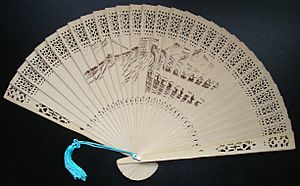
The oldest Chinese fans found are from the 2nd century BCE. They are woven bamboo, wood, or paper fans. The Chinese character for "fan" (扇) comes from a picture of feathers under a roof. A certain type of fan was linked to a person's status and gender. During the Song dynasty, famous artists often painted fans. The Chinese dancing fan was developed in the 7th century. The Chinese hand fan was a row of feathers on a handle. In later centuries, Chinese poems and four-word sayings were used to decorate fans with Chinese calligraphy. In ancient China, fans came in many shapes (like a leaf, oval, or half-moon). They were made from different materials like silk, bamboo, and feathers.
Carved Lacquer Art
Carved lacquer, or Qīdiāo (Chinese: 漆雕), is a special Chinese art form using decorated lacquerware. Lacquer has been used in China for at least 3,000 years. But the technique of carving into very thick layers of lacquer seems to have started in the 12th century CE. It takes a very long time to make. It has always been a luxury item, mostly found in China. It was copied in Japan in slightly different styles. The process is called Diāoqī (雕漆/彫漆, carving lacquer).
Most examples we have today are from the Ming and Qing dynasties. But the main types of designs for carvings all started in the Song dynasty. The development of these designs and the carving technique were mostly finished by the early Ming period. These designs included abstract patterns, figures in landscapes, and birds and plants. Designs with religious symbols, animals, lucky characters, and imperial dragons were also added. The objects made using this technique are mostly small, practical items like boxes, plates, and trays. Some screens and pieces of Chinese furniture were also made. Carved lacquer is rarely combined with lacquer painting or other lacquer techniques.
Folding Screens
A folding screen (simplified Chinese: 屏风; traditional Chinese: 屏風) is a type of free-standing furniture. It has several frames or panels, often connected by hinges. It can be made in many designs and with different materials. Folding screens have many practical and decorative uses. They started in ancient China. Eventually, they spread to the rest of East Asia, Europe, and other parts of the world.
Screens date back to China during the Eastern Zhou period (771–256 BCE). These were first single-panel screens. Folding screens were invented during the Han dynasty (206 BCE – 220 CE). Pictures of these folding screens have been found in Han-era tombs. Folding screens were first made from wooden panels and painted on lacquered surfaces. Later, folding screens made from paper or silk became popular too.
Even though folding screens were used since ancient times, they became very popular during the Tang dynasty (618–907). During the Tang dynasty, folding screens were perfect for painters to show their paintings and calligraphy. Many artists painted on paper or silk and put it onto the folding screen. There were two main artistic folding screens mentioned in historical writings. One was the huaping (simplified Chinese: 画屏; traditional Chinese: 畫屏; literally "painted folding screen"). The other was the shuping (simplified Chinese: 书屏; traditional Chinese: 書屏; literally "calligraphed folding screen"). People often asked artists to create folding screens for them. Landscape paintings on folding screens reached their peak during the Song dynasty (960–1279).
Chinese Jade
Chinese jade (玉) refers to jade found or carved in China since the Neolithic age. It is the main hardstone used in Chinese sculpture. While deep green jadeite is well-known in Europe, for most of China's history, jade came in many colors. White "mutton-fat" nephrite was the most valued. Jade was prized for its hardness, durability, musical qualities, and beauty. Its soft, translucent colors and protective qualities made it linked to Chinese ideas of the soul and immortality.
The most important early use was making the Six Ritual Jades. These have been found since the 3rd-millennium BC Liangzhu culture. They include the bi, the cong, the huang, the hu, the gui, and the zhang. Their original meaning is unclear because they are so old. But by the time of the Rites of Zhou, they were thought to represent the sky, the earth, and the four directions. By the Han dynasty, royal families were buried in jade burial suits sewn with gold thread. People believed this would preserve the body and soul. Jade was also thought to fight tiredness in living people. The Han also greatly improved how jade was used in art.
Mythological Creatures in Chinese Culture
The Loong (Chinese Dragon)
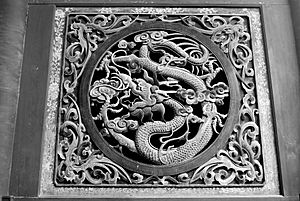
Loongs, also known as Chinese Dragons, are legendary creatures in Chinese mythology, Chinese folklore, and East Asian culture. Chinese dragons have many animal-like forms, like turtles and fish. But they are most often shown as snake-like with four legs. They traditionally stand for powerful and lucky forces. They are especially linked to controlling water, rainfall, typhoons, and floods. The dragon is also a symbol of power, strength, and good luck for those who deserve it. During Imperial China, the Emperor of China often used the dragon as a symbol of his power. They also represent the Son of Heaven, the Mandate of Heaven, and the Celestial Empire.
The Fenghuang (Chinese Phoenix)
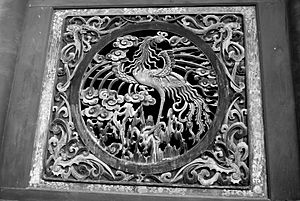
Fenghuang (鳳凰) are mythological birds found in Chinese and East Asian stories. They are said to rule over all other birds. The males were originally called feng and the females huang. But this difference is often no longer made. They are now seen as a single female creature. This allows them to be paired with the Chinese dragon, which is traditionally seen as male. The fenghuang is also called the August Rooster. This is because it sometimes takes the place of the Rooster in the Chinese zodiac. In the Western world, it is often called the Chinese phoenix or simply Phoenix. However, its similarities to the Western phoenix are only on the surface.
The Qilin
The Qilin ([tɕʰǐ.lǐn]; Chinese: 麒麟), or Kirin in Japanese, is a mythical hooved chimerical creature in Chinese culture. It is said to appear when a sage (wise person) or famous ruler is about to arrive or pass away. Qilin is a specific type of the lin mythological family of one-horned beasts. The earliest mentions of the qilin are in the 5th century BC Zuo Zhuan. The qilin appeared in many later Chinese history and fiction works.
Xuanwu (Black Tortoise)
Xuanwu (Chinese:玄武) is one of the Four Symbols of the Chinese constellations. Despite its English name, it is usually shown as a turtle wrapped together with a snake. It is known as Genbu in Japanese and Hyeonmu in Korean. It represents the north and the winter season. In Japan, it is one of the four guardian spirits that protect Kyoto. It is said to protect the city from the north. The creature's name is the same as the important Taoist god Xuanwu. He is sometimes shown with a turtle and snake.
Music, Instruments, and Dance

Music and dance were closely linked in early China. The music of China goes back to the start of Chinese civilization. Documents and artifacts show a well-developed musical culture as early as the Zhou dynasty (1122 BCE – 256 BCE). The earliest music from the Zhou dynasty recorded in ancient texts is ritual music called yayue. Each piece might have been linked to a dance. Some of the oldest written music dates back to Confucius's time. The first major time Chinese music truly flourished was with the popularity of the qin (a plucked instrument with seven strings) during the Tang Dynasty. However, this instrument was important even before the Han Dynasty.
Many musical instruments are key to Chinese culture. These include the Xun (an Ocarina-like instrument), Guzheng (a zither with movable bridges), guqin (a bridgeless zither), sheng and xiao (vertical flute), the erhu (a bowed string instrument), pipa (a pear-shaped plucked instrument), and many others.
Dance in China is a very diverse art form. It includes many modern and traditional dance styles. Dances range from folk dances to performances in opera and ballet. They can be used in public celebrations, rituals, and ceremonies. There are also 56 officially recognized ethnic groups in China. Each ethnic minority group has its own folk dances. The most famous Chinese dances today are the Dragon dance and the Lion Dance.
Chinese Architecture
Chinese architecture is a style of architecture that has developed over ages. It has influenced the buildings of East Asia for many centuries. The main rules of Chinese architecture have stayed mostly the same. Only the decorations have changed. Since the Tang dynasty, Chinese architecture has greatly influenced styles in Japan and Korea. Chinese architecture is almost as old as Chinese civilization. It has been an important sign of Chinese culture for a long time.
Certain features are common in Chinese architecture, no matter the region or use. The most important is symmetry. This means buildings are balanced on both sides. This gives a feeling of grandeur, from palaces to farmhouses. One exception is in garden design, which tends to be as unbalanced as possible. Like Chinese scroll paintings, the idea behind a garden is to create a flowing experience. Visitors can wander and enjoy the garden freely, like in nature. Feng shui has been very important in building design. The Chinese garden is a landscape garden style that has developed over three thousand years. It includes huge gardens for emperors and smaller, more private gardens for scholars. These gardens create an ideal miniature landscape. They are meant to show the harmony between man and nature. A typical Chinese garden has walls around it. It includes ponds, rocks, trees, flowers, halls, and pavilions. These are connected by winding paths. As visitors move from one building to another, they see a series of carefully designed scenes.
Chinese Palaces
A Chinese palace is a large imperial complex. It was where the royal court and government lived. Its buildings are big and fancy. The Chinese character gong (宮; meaning "palace") shows two connected rooms under a roof. Originally, the character meant any residence. But since the Qin dynasty (3rd century BC), it only referred to the emperor's home.
A Chinese palace has many buildings. It has large areas surrounded by walls and moats. It contains big halls for ceremonies and official business. It also has smaller buildings, temples, towers, homes, galleries, courtyards, gardens, and other buildings. Besides the main imperial palace, Chinese dynasties also had other imperial palaces in the capital city. These were for the empress, crown prince, or other royal family members. There were also "away palaces" outside the capital. Emperors stayed there when traveling. Empress dowager Cixi built the Summer Palace or Yiheyuan (頤和園/颐和园 – "The Garden of Nurtured Harmony") near the Old Summer Palace.
Paifang (Archways)
Paifang, also known as a Pailou, is a traditional style of Chinese architectural arch or gateway structure. It is related to the Indian Torana. The word paifang (Chinese: 牌坊; pinyin: páifāng) first meant the top two levels of administrative divisions in ancient Chinese cities. The largest division in a city was a fang (Chinese: 坊; pinyin: fāng), like a modern ward. Each fang had walls or fences. Their gates were closed and guarded every night. Each fang was divided into several pai (Chinese: 牌; pinyin: pái; literally "placard"), like a modern community. Each pai included an area with several hutongs (alleyways). This system was very detailed during the Tang dynasty. It continued in later dynasties. For example, during the Ming dynasty, Beijing had 36 fangs. Originally, paifang referred to the gate of a fang or the entrance to a building complex or town. But by the Song dynasty, a paifang became a purely decorative monument.
Chinese Gardens
The Chinese garden is a landscape garden style that has changed over many years. It includes the huge gardens of the Chinese emperors and royal family. These were built for pleasure and to impress. It also includes smaller gardens made by scholars, poets, and merchants. These were for quiet thought and escape from the outside world. They create an ideal miniature landscape. This is meant to show the harmony that should exist between people and nature.
A typical Chinese garden is surrounded by walls. It has one or more ponds, rock formations, trees, and flowers. It also has various halls and pavilions inside. These are connected by winding paths. As visitors move from one building to another, they see a series of carefully designed scenes. These scenes unfold like a scroll of landscape paintings.
The earliest Chinese gardens were created in the Yellow River valley during the Shang dynasty (1600–1046 BC). These gardens were large enclosed parks. Kings and nobles hunted game there, or grew fruits and vegetables. Early writings from this time have three Chinese characters for garden: you, pu, and yuan. You was a royal garden for birds and animals. Pu was a garden for plants. During the Qin dynasty (221–206 BC), yuan became the character for all gardens.
The old character for yuan is a small picture of a garden. It is enclosed in a square, which can represent a wall. It has symbols that can represent a building, a small square for a pond, and a symbol for plants or a pomegranate tree. According to the Shiji, one famous feature of an ancient garden was the Wine Pool and Meat Forest. A large pool, big enough for several small boats, was built. It was lined with polished oval stones and filled with wine. A small island was built in the middle of the pool. Trees were planted there, with skewers of roasted meat hanging from their branches. King Zhou and his friends and concubines floated in their boats, eating the roasted meat. Later Chinese thinkers said this garden was an example of being too wasteful.
Martial Arts
China is one of the main birthplaces of Eastern martial arts. Chinese martial arts are often called kung fu and wushu. These are hundreds of fighting styles that have developed over centuries in China. These styles are often grouped by common features. They are called "families" (家; jiā), "sects" (派; pài), or "schools" (门/門; mén) of martial arts. Examples include Shaolinquan (Chinese: 少林拳), which uses movements that copy Five Animals (Chinese: 五形). Or training methods inspired by old Chinese philosophies, religions, and legends.
Styles that focus on qi (life energy) are called "internal" (內家拳/内家拳; nèijiāquán). Others that focus on improving muscle and heart fitness are called "external" (外家拳; wàijiāquán). Grouping by geography, like "northern" (北拳; běiquán) and "southern" (南拳; nánquán), is also popular.
Chinese martial arts are known as Kung Fu ("human achievement") or Wushu ("martial arts"). China is also home to the respected Shaolin Monastery and Wudang Mountains. The first martial arts started for survival and warfare, not just art. Over time, some art forms changed, while others kept a distinct Chinese feel. China has produced some of the most famous martial artists, including Wong Fei Hung. The arts have also used many different weapons, including the standard 18 arms. Legendary moves like Dim Mak are also talked about in the culture. Martial arts schools also teach the art of lion dance. This has changed from a fighting display to an entertaining dance performance.
Leisure Activities
Many and pastimes are popular in Chinese culture. The most common game is Mahjong. The same pieces are used for other games like Shanghai Solitaire. Other games include pai gow, pai gow poker, and other bone domino games. Weiqi (Go) and xiangqi (Chinese chess) are also popular. Ethnic games like Chinese yo-yo are also part of the culture. They are performed at social events.
Qigong is a practice of spiritual, physical, and medical techniques. It is a form of exercise. While it is commonly used by older people, anyone of any age can practice it in their free time.
Chinese Cuisine (Food Culture)
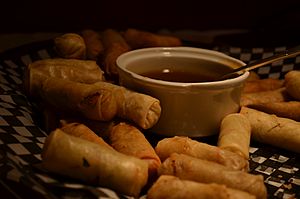
Chinese cuisine is a very important part of Chinese culture. It includes food from different regions of China and from Chinese people around the world. Because many Chinese people live in other countries, and because of China's historical power, Chinese food has influenced many other cuisines in Asia. These foods were changed to fit local tastes.
The seasoning and cooking techniques of Chinese provinces depend on their history and ethnic groups. Geographic features like mountains, rivers, forests, and deserts also greatly affect the ingredients available. This is because China's climate ranges from tropical in the south to subarctic in the northeast. Imperial, royal, and noble preferences also played a role in how Chinese cuisines changed. Because of imperial expansion and trade, ingredients and cooking techniques from other cultures were added to Chinese cuisines over time.
The most praised "Four Major Cuisines" are Chuan, Lu, Yue, and Huaiyang. These represent West, North, South, and East China cuisine. Modern "Eight Cuisines" of China are Anhui, Cantonese, Fujian, Hunan, Jiangsu, Shandong, Sichuan, and Zhejiang cuisines. Color, smell, and taste are the three traditional ways to describe Chinese food. The meaning, appearance, and nutrition of the food are also important. It is not polite to use knives at the dining table. Chopsticks are the main eating tools for Chinese food. They can be used to cut and pick up food.
Tea Culture
Drinking tea has a long history in China. It started there. The history of tea in China is long and complex. Chinese people have enjoyed tea for thousands of years. Scholars said tea could cure many illnesses. Rich people thought drinking good tea showed their status. Common people simply enjoyed its flavor. In 2016, the earliest known physical proof of tea was found. It was in the tomb of Emperor Jing of Han in Xi'an. This showed that tea from the Camellia plant was drunk by Han dynasty emperors as early as the 2nd century BC. Tea then became a popular drink in the Tang (618–907) and Song (960–1279) Dynasties.
Although tea started in China, Chinese tea generally means tea leaves processed using old Chinese methods. A popular story says that Chinese Emperor Shen Nong discovered tea in 2737 BCE. A leaf from a nearby bush fell into water the emperor was boiling. Tea is deeply connected to China's history and culture. The drink is considered one of the seven necessities of Chinese life. These are firewood, rice, oil, salt, soy sauce, and vinegar. During the Spring and Autumn period, Chinese tea was used for medicine. This was when Chinese people first enjoyed the juice from chewing tea leaves.
Chinese tea culture refers to how tea is made and when people drink it in China. Tea culture in China is different from that in European countries like Britain and other Asian countries like Japan. This includes how it's prepared, its taste, and the occasions for drinking it. Even today, tea is drunk regularly, both casually and formally. Besides being a popular drink, tea is used in traditional Chinese medicine and in Chinese cooking. Green tea is one of the main teas from China.
Food and Dining Customs
Imperial, royal, and noble preferences played a role in how Chinese cuisines changed over time. Because of imperial expansion and trade, ingredients and cooking techniques from other cultures were added to Chinese cuisines. The huge variety of Chinese food comes mainly from the dynastic periods. Emperors would host banquets with over 100 dishes per meal. Many imperial kitchen staff and concubines were involved in preparing the food. Over time, many dishes became part of everyday meals for common people. Some of the best restaurants with recipes close to the dynastic periods include Fangshan restaurant in Beihai Park Beijing.
The Manhan Quanxi, or Manchu Han Imperial Feast, was one of the grandest meals ever recorded in Chinese cuisine. It had at least 108 unique dishes from the Manchu and Han Chinese cultures during the Qing dynasty. It was only for the Emperors. The meal lasted for three full days, across six banquets. The cooking skills included methods from all over Imperial China. When the Manchus conquered China and founded the Qing dynasty, the Manchu and Han Chinese peoples struggled for power. The Kangxi Emperor wanted to solve these problems. So he held a banquet during his 66th birthday celebrations. The banquet had Manchu and Han dishes, with officials from both ethnic groups attending together. After the Wuchang Uprising, common people learned about the imperial banquet. The original meal was served in the Forbidden City in Beijing.
Major Subcultures
Chinese culture has many subcultures. In China, the cultural difference between neighboring provinces can be as big as that between neighboring European nations. So, the idea of Han Chinese subgroups (漢族民系/汉族民系, meaning "Han ethnic lineage") was created. This is used to classify these subgroups within the larger Han ethnicity. These subgroups are usually classified based on differences in language.
Some well-known subcultures within China include:
North China Cultures
- Hui culture
- Culture of Beijing (京)
- Culture of Shandong (魯/鲁)
- Culture of Gansu
- Dongbei culture (東北/东北)
- Shaanxi culture
- Jin culture (晉/晋)
- Zhongyuan culture (豫)
South China Cultures
- Haipai culture (海)
- Hakka culture (客)
- Hokkien culture (閩)
- Hong Kong culture (港)
- Hubei culture (楚)
- Huizhou culture (徽)
- Hunanese culture (湘)
- Jiangxi culture (贛)
- Jiangnan culture
- Lingnan culture (粵/粤)
- Macanese culture
- Sichuanese culture (蜀)
- Taiwanese culture (台)
- Teochew culture (潮)
- Wenzhou culture (欧)
- Wuyue culture (吳/吴)
Images for kids
-
A traditional red Chinese door with Imperial guardian lion knocker.
-
Journey to the West (西遊記/西游记).
-
Wooden sculpture of Guanyin.
-
Que pillar gates of Chongqing that once belonged to a temple.
-
"Nine Dragons" handscroll section, by Chen Rong (1244 CE), Song dynasty.
-
Traditional clothing from the Ming dynasty.
-
Oolong tea leaves steeping in a gaiwan.
-
Ming table in the Victoria and Albert Museum, 1425–1436.
See also
 In Spanish: Cultura de China para niños
In Spanish: Cultura de China para niños
- Bian Lian
- Chinese animation
- Chinese ancestral veneration
- Chinese art
- Chinese Buddhism
- Chinese cinema
- Chinese clothes
- Chinese food
- Chinese dance
- Chinese dragon
- Chinese drama
- Chinese festival
- Chinese folklore
- Chinese folk religion
- Chinese garden
- Chinese instrument
- Chinese jade
- Chinese literature
- Chinese marriage
- Chinese name
- Chinese opera
- Chinese orchestra
- Chinese paper cutting
- Chinese sphere of influence
- Chinese studies
- Color in Chinese culture
- Customs and etiquette in Chinese dining
- Go
- I Ching's influence
- Numbers in Chinese culture
- Peking opera
- Science and technology in China
- Chinese astronomy
- Chinese calendar
- Chinese mathematics
- Chinese medicine
- Chinese units of measurement
- Taoism
- Tian-tsui
- Xiangqi




